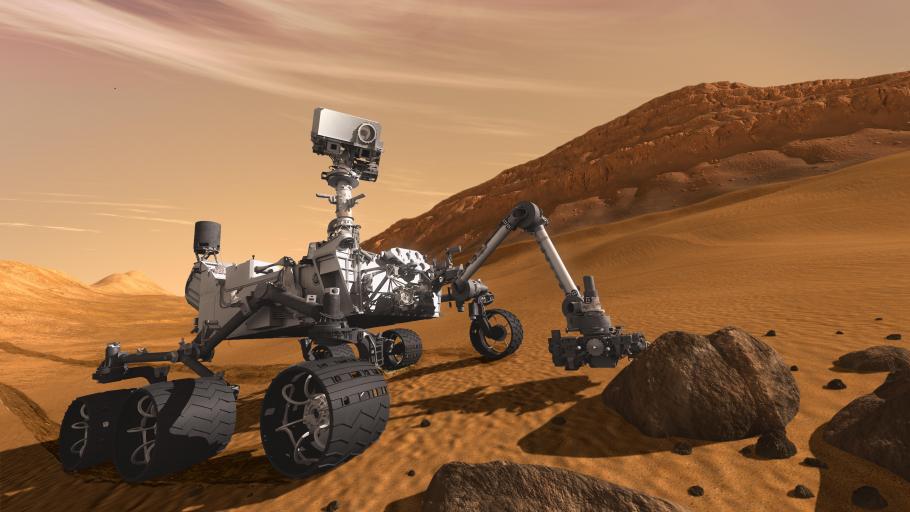Artist concept of rover Curiosity on Mars.
Figure 1. Artist’s rendition of the Mars Science Laboratory rover on the floor of Gale crater.1
The Mars Science Laboratory (MSL) Curiosity was launched to Mars in late 2011 and landed in the Red Planet in early August of 2012. The main objective of the MSL mission is to "assess habitability" of both Mars' past and present environments1. The rover landed in Gale crater in order to study the potential habitability of the ancient environments recorded there by local rock outcroppings.
Curiosity is rich with technological advancements starting with a new innovative landing procedure and extending to the types of instruments loaded onto the very capable rover. The landing involved the descent of the spacecraft by parachute and immediately prior to landing, the lowering of the rover on a tether to the surface1. The MSL rover is equipped to roll over obstacles up to 75 cm high. Through scooping and drilling the surface, the rover is collecting soil and rock samples that can be chemically analyzed in situ in test-chambers on the rover. To assess past habitability at the landing site, sample analyses focuses on identifying organic components, such as proteins and amino acids, and atmospheric gases essential for life. A few of the instruments incorporated into the rover structure include the Mast Camera, the ChemCam, the Sample Analysis at Mars Instrument Suite, Radiation Assessment Detector, and the Rover Environmental Monitoring program1.

Figure 2. The Curiosity rover landed in the ~100 mile diameter Gale crater that was formed by the impact of a meteorite in the ancient history of the planet. The rover targeted (black outlined ellipse) the north side of a tall mountain in the center of the crater (dubbed Mt Sharp) in order to access the layers forming the mountain and understand how they were deposited and what conditions were like on Mars during their emplacement. Credit: NASA/JPL-Caltech/ESA/DLR/FU Berlin/MSSS
Dr. John Grant is a member of the Mars Science Laboratory science team and participates as a Long Term Planner and member of the Geology Theme Group. As a Long Term Planner (or LTP) he helps to plan what the rover will be doing over the coming days and weeks as it continues traversing up Mt Sharp. To date, the rover has traversed upwards through a thick sequence of ancient lake beds and is moving through and into a transition to rocks that are more enriched in sulfates and likely record the drying of Gale crater and Mars over time. Ongoing work has includes drilling into the rocks and analyzing the resultant samples and has confirmed that at widespread areas on the floor of Gale crater were characterized by river-lain gravels and lake-deposited mudstones that represented an ancient habitable environment.
1. NASA Jet propulsion Laboratory (2008). http://mars.jpl.nasa.gov/msl
